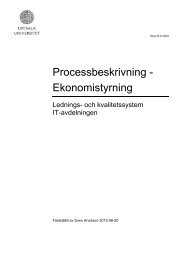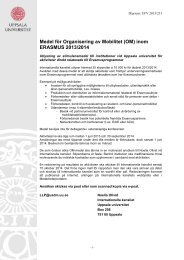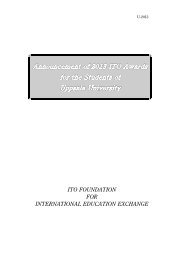Uppsala Universitet – International student guide 2012/2013
Uppsala Universitet – International student guide 2012/2013
Uppsala Universitet – International student guide 2012/2013
Create successful ePaper yourself
Turn your PDF publications into a flip-book with our unique Google optimized e-Paper software.
Higher education and<br />
research in Sweden<br />
Higher education in Sweden is divided into<br />
three distinct levels; First cycle (undergraduate),<br />
Second cycle (master’s) and Third cycle<br />
(doctoral). In more than thirty locations in<br />
Sweden you will find a university or a university<br />
college. There are 16 universities and<br />
27 university colleges in the country.<br />
The universities, such as <strong>Uppsala</strong> University,<br />
generally offer a wider selection of<br />
courses than the university colleges. At the<br />
universities you can study subjects from<br />
all the academic fields and at all educational<br />
cycles. The Ministry of Education<br />
and Research is responsible for all higher<br />
education and research in Sweden. As of<br />
the academic year 2007/2008, Sweden has<br />
adopted the higher education degree structure<br />
and other reforms in line with the current<br />
Europe-wide Bologna Process aiming<br />
at making higher education structures in<br />
Europe transparent.<br />
Many <strong>student</strong>s continue after the master’s<br />
level to the doctoral level. The Conferment<br />
Ceremony takes place twice a year in<br />
the distinguished Grand Auditorium of the<br />
University Building.<br />
The university decides on an annual<br />
basis which courses it wishes to offer, although<br />
the course offerings do not change<br />
substantially from one year to another. In<br />
Sweden, studies are usually confined to<br />
one subject at a time during a given semester,<br />
which is a marked difference from, for<br />
Student lIFe<br />
instance, the case in the USA and in most<br />
other countries. Single subject courses<br />
vary in length from 7.5 to 60 credits and<br />
may be combined into a programme leading<br />
to a degree but not to a professional<br />
degree.<br />
Credits, Grades and Examination<br />
The duration and extent of programmes<br />
and courses are expressed in a system of<br />
credits (högskolepoäng). The Swedish credit<br />
is the same as the European ECTS credits.<br />
Thus, one week of full-time study corresponds<br />
to 1.5 credits. One semester of fulltime<br />
study is equal to 30 credits (15 U.S. or<br />
Canadian semester credits). The requirement<br />
for most undergraduate degrees is less<br />
than 240 credits, corresponding to a minimum<br />
study time of between 3 and 4 years,<br />
respectively. A master degree, two years, is<br />
thus 120 credits.<br />
The credit system is very systematic. If<br />
a course has 7.5 credits it corresponds to<br />
five weeks of full-time work if no parallel<br />
courses are taught at the same time.<br />
Students usually take one course at a time<br />
even though courses of short duration (for<br />
instance 7.5 credits) often run parallel<br />
with another course of 7.5 credits during<br />
a 10-week period. Please note that in<br />
Sweden the number of teaching hours per<br />
week may vary considerably between different<br />
subjects and courses.<br />
21





